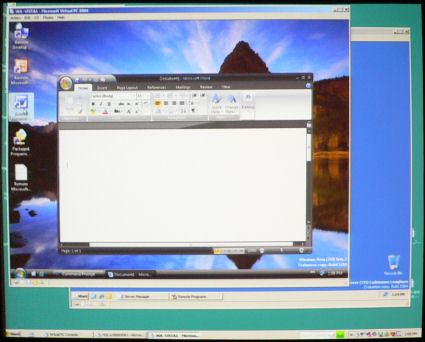TechEd 2006: Longhorn's Terminal Services to run Office, Windows
Boston (MA) - At a packed demonstration of new features in the latest beta edition of Windows Server "Longhorn" on Wednesday, Microsoft technical program manager Ward Ralston revealed that the company's new version of Terminal Services will enable client computers to run full applications such as Word with distributed processing. Just the container application - the window - runs on the client, while the engine of the application runs through the server.
What this could conceivably make possible, Ralston said, is a setup where very small mobile clients, conceivably including smart phones, could run full applications such as the Microsoft Office suite, with little or no perceivable difference to the user (except, perhaps, a much smaller screen and a tiny keyboard). The container application would be all that's installed on the client system - a very small install made available through an ordinary .MSI installer package.
In this demo from TechEd 2006, there are two Virtual PC windows, the foremost of which is running Vista, the other Longhorn. Here, the Longhorn server is providing the engine for Word 2007, which is interacting with the container application in Vista over Terminal Services.
While this setup resembles using Remote Desktop, there's a key difference, as Ralston explained: Under this new Terminal Services scheme, a Remote Desktop client may be able to run any application installed on the server in such a way that it appears to be installed on the user's client machine. While the user wouldn't see any difference, the engine for the application would actually be running from the server through Terminal Services, communicating over the network or the Internet by way of the user's discrete Active Directory account. All that communication would take place "under the hood," out of sight of the user.
As Ralston explained, through the new Terminal Services remote snap-in to Microsoft Management Console in Longhorn, a procedure can be launched that inventories all the applications available on the server, and profiles them for their availability for remote operation. The user would see icons on her desktop enabling her to launch these remote apps. But these icons would actually be shortcuts that run so-called RDP packages. The administrator constructs these packages using a new tool in Longhorn, that generates an .MSI installer file for the client based on the container components already installed on the server. This .MSI file is run by the client, placing just the minimum files she needs on her system. The procedure is almost automated, and the user's rights to run applications remotely can be governed through group policies.
What Microsoft is working on now is the ability to extend terminal services through the Web, so that conceivably, any authorized user can run Windows applications remotely. This won't render Windows apps cross-platform; they'll still require Internet Explorer, which itself requires Windows. But this could enable a scenario where a terminal-for-hire, perhaps installed at an airport or hotel, could make a user's own applications available to him through his company's server, just by using the Web browser.
A menu of Windows applications available remotely through Terminal Services. Their engines aren't installed on Vista, though their container windows are.
Get Tom's Hardware's best news and in-depth reviews, straight to your inbox.
In a demonstration Wednesday, Ward Ralston demonstrated a Terminal Services Remote Programs site being accessed by IE7. Instead of a desktop, the site presents a simple, Windows Explorer-like list of applications that have been inventoried by the server as TS capable, and are being managed by Remote Services. Ralston clicked on Paint, and after a few panels of validating user credentials, the system brought up Paint. On the surface, this is an unremarkable program, until you realize that all the functions that determine how the program responds to mouse gestures, are communicating with the container window program over the network.
Stay with TG Daily for more from the final day of events at Microsoft's TechEd 2006 conference in Boston.

